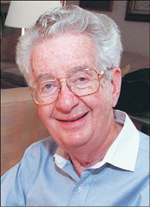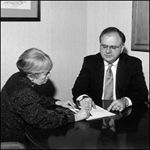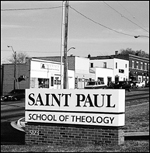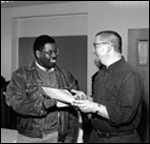Lovett H. Weems, Jr., for fourteen years president of Saint Paul School of Theology in Kansas City, Missouri, and W. Clark Randall, eight years chair of the school’s board of trustees, are members of a flourishing mutual admiration society. In recent, separate interviews each man said of the other, “He’d make anybody he worked with look good.”
The power of that mutual regard may well be part of Weems’s staying power and the notable successes of his administration. Fourteen years is a long time to be president of a seminary—the average tenure is somewhat under seven years—but Lovett Weems isn’t looking tired. “After fourteen years, the school you came to doesn’t exist anymore,” Weems said. “It feels like the second year of a different presidency.”
Four and a half years is the average tenure of currently serving board chairs, according to a new In Trust survey (although one hardy soul has held the post for thirty-nine). Clark Randall has put in almost double that. But after eight years in the post, he recently sent out a letter announcing that he is stepping down. “I think it’s time for new blood and fresh thinking,” he said, “and since I’ve been snowbirding”—he lives in Kansas City for about eight months each year and in Daytona, Florida, through the winter—“I don’t feel like I’m as connected as I’d like. I called the school today about plans for our self-study, and I thought, ‘I should be there.’”
In their eight years as a team, Weems and Randall have worked together to lead a school past a period of crisis into a time of relative calm, substantial financial growth, and a sense of considerable community and goodwill. Or, as Weems summarizes it, “a shift from ‘What are our vulnerabilities?’ to ‘What are our possibilities?’”

|
| Clark Randall (top) and Lovett Weems (bottom, with Susan Sonnenday Vogel, the executive vice president) together turned the tide for St. Paul School of Theology, putting it on a sound economic footing and making it a force in its community.
|
Times of Testing
They both have memories of more troubled times. Weems knew that all was not well financially at the United Methodist school when he accepted Saint Paul’s presidency in 1985. (“We were honest about all that we knew,” said Randall, who was already a board member then, “but we didn’t know it all either.”) Many schools went through fiscally challenging times in the early 1980s. “I’m not interested in being negative about those who preceded us,” said Weems, but he went on to list some causes of the crisis he inherited: inadequate budgeting; tuition too low, the result of 1970s inflation; excessive spending from the endowment; using non-renewing income for ongoing needs. Weems came to Saint Paul from the vice presidency at Wesley Theological Seminary in Washington, D.C., where he was responsible for development. Wesley was another school that was not having its happiest financial moment, and Weems says that job helped prepare him for the presidency. Nothing could have prepared him, though, for the memorable August day less than a month into his tenure when the cash flow was so scant and the school’s bill payments so slow that the bookstore manager warned him that suppliers wouldn’t ship books, the food services manager announced that wholesalers wouldn’t send food, and the business manager informed him that there wasn’t enough cash on hand to cover the payroll. “You learn twenty-five percent of what’s going on at a school at the interview,” deadpans Weems. “You learn twenty-five percent when you’re hired. The rest”—he paused, smiled wryly—“you learn.”
On September 1 of that year, the school cut its budget by ten percent—a draconian process, although it was managed without laying off anyone—and stopped borrowing. Over the next six months the school determined just how much it owed. And over the next ten years, they paid it. Saint Paul also balanced its budget that first year—“just barely,” according to Weems. The school has maintained a balanced budget ever since.

|
Randall joined the board in 1978 during what he gently calls the school’s “adolescent period.” Saint Paul School of Theology opened in 1959, founded in recognition that there was a large swath of Middle Western America with lots of Methodists and no Methodist theological institutions. The first president, Don Holter, served until he was elected bishop of Nebraska in 1972. The second president, William McElvaney, served until 1985, when he went to Perkins School of Theology at Southern Methodist University as professor of preaching and worship. Thus Randall has been on the board for more than half of the school’s life. “I wish I had known more about the financial situation,” he says now. “I didn’t ask the questions at a time when so many other issues were involved.”
One of the issues was the board itself. At its most bloated, it comprised eighty-eight members, only seven of whom were selected by the board. “The board was predominantly made up of people who were there because of their other job,” Randall said. “There wasn’t necessarily a feeling of ownership.” The decision to shrink the board was made just before Weems arrived. Now the board has slimmed to forty members, thirty-two of them chosen through a board selection process. Since attendance at board meetings is now close to 100 percent, the actual numbers of board members at meetings have increased.
Developing a Participatory Board
Clark Randall, in his words, “watched the school from afar,” even before he joined the board. It wasn’t all that far, in fact. In those days he lived and worked in Kansas City as an executive in product development for Hallmark Cards. It was a period in which greeting cards went from 95 percent to 50 percent of the company’s total sales. “We had to adapt each product to Hallmark,” he explained, “and ask questions like: ‘Is this going to appeal to anybody? Is this going to fly? What backup do we have? What supports?’ And always we had to live up to the standards of the founder, who would ask, ‘Is this card worthy of my name on it? Could it be better?’” Randall spent time on the board, including a stint as chair, at Baker University, a Methodist institution in Kansas. When he cycled off that board, McElvaney, Weems’s predecessor, asked him on to the Saint Paul board. “The school’s image was not everything it should have been, and it had more than its share of financial stresses and strains,” he remembered, “but the faculty was more than enthusiastic, and the product was good.”
The theme of Randall’s commitment to the “product” of the school runs through his conversation. “In terms of personal ministry, nothing affects the church more in the long run than being a seminary trustee,” he said. He applauds a friend of the school who recruits donors by pointing out, “If we expect to have churches tomorrow, we must train ministers today.”
The rest of the Saint Paul board took note of Randall’s unquenchable enthusiasm. When it decided (at a board retreat and after a long process of board development) that its next chair did not have to be a bishop, “Everyone on the committee just knew that Clark was the one,” said Weems. Mai Gray, a retired educator who was on the board then (and still is), says of Randall, “Clark has all the gifts and graces of a leader. He makes the board feel an important part of the leadership process. He’ll greet me in the hallway with a ‘Mai Gray, how are you?’” Her voice got very soft after the hearty impersonation. “I really felt sad when I read the letter” announcing his resignation as chair, she said.
According to Randall, the downsized board’s first assignment was to “bring in lay people of particular professional talents.” How? “Lovett’s a pretty good salesman,” he laughed. Weems’s own take on the matter is: “You attract strong trustees with strong trustees.” Some of the people the board was looking for were close at hand and already sold. The Saint Paul Council, a group Weems created almost as soon as he arrived at the school, is made up of $1,000-per-year donors and has been the conduit through which a number of current board members first entered the school’s life. The council currently has 214 members. Vice president for development Neil Blair came to the school in 1988. His style runs slightly counter to common wisdom, he says: “Our approach is not cultivate, cultivate, cultivate, ask—it’s ask, then cultivate, cultivate, cultivate.” And cultivate he does—his travel schedule is formidable, and occasionally involves preaching at the funeral of someone in a council member’s family. He says of Randall and Weems that “they make it their business to know people.”
Building a Strong Relationship
“Over time, the board has become a community,” said Randall, “and I think I have one of the easiest jobs. I’m naturally an enthusiastic and supportive person.”
A fair amount of that support is focused on Saint Paul’s president. “Once in a while, a president will almost get overwhelmed with immediate issues,” Randall explained. “Then my job is to listen and try to help, and then to come back later and ask how that’s going.”
“Just talking with him gets you clearer,” said Weems. The two talk every two or three weeks, and Weems said, “When we get together, he’s got a list and I’ve got a list. Of course his is typed and supplemented with clippings he’s seen! And the lists usually overlap by about eighty percent.”

|
| St. Paul's neighborhood (above) may not be the best, but the school's presence is having a positive effect according to student board member Golden Neal (below, left with Grant S. White, assistant professor of church history and history of Christian worship).
|
Randall is also serious about the board chair’s more formal support of the president. “I know that some companies have dropped annual evaluations of their presidents, but since we’re so far from the day-to-day of the school, it’s absolutely necessary that our board do this, and that it involve more than just a form. We do in-depth interviews with faculty, students, and staff. It must be ongoing, non-threatening, and for the president’s sake. The section on health is too often neglected: the president should be sufficiently staffed so that he can take time off, relax, regroup. That’s a challenge with Lovett: he has a conscientious attitude that sort of prevents him taking time off.”
The genuine concern for others involved with the school modeled by Randall and Weems does seem to have permeated the school’s culture. It shows up in small ways—the prayer request bulletin board in the lounge, for example, supplemented by a prayer request box on Saint Paul’s web site. Weekly community lunches are solidly attended and lively.
Faculty speak with gratitude about the free flow of information—and are delighted that they can openly share their concerns with Randall when they think there has been a blip in that communication. One example: Weems recently secured a significant grant essentially on his own. “It wasn’t that he intentionally kept us in the dark,” said a faculty member, “it’s just that he didn’t keep us up to speed. But Clark was really attentive during the evaluation process.” It shows particularly clearly in the office of Susan Sonnenday Vogel, executive vice president and lecturer in church leadership. Vogel has been at the school longer than anyone else; she knows the stories because she has made her office the nerve center of the school. Randall calls her “the glue that holds everything together.” And it shows in the school’s involvement in its troubled community.

|
Saint Paul sits on a sixteen-acre hilly green campus. Directly across from the front entrance, however, is a green and very empty factory. Farther up the street are A&E Furniture Refinishing, Thunder Road Cycles, and a dubious watering hole called the Harmony Bar. (When the school did a parking survey on a street that used to run through the campus, they discovered that it was used almost exclusively by Harmony Bar patrons who wanted to stay anonymous by parking off the main street.) Otherwise the neighborhood seems to consist mainly of $50-a-week used car lots. A group of business people called the Truman Road Corridor Association has been meeting at Saint Paul, though, and Weems testified before the parks committee in order to get cleanup happening and renovations started at a park abutting the campus. The school inherited its grounds and buildings—a few of them usable—from a deaconess training center founded in 1904. There have been debates from time to time about moving, but the school takes its location seriously and seeks to be a positive presence in the community. Student board member Golden Neal says the community is responding in its own fashion: “I was walking across campus late one night, and some locals were coming the other way using, well, colorful language. They saw me, stopped, and said, ‘Oh, excuse us.’”
A Man Who Cares Enough . . .
More than one person at Saint Paul was unable to resist the temptation to describe Randall as a walking, talking Hallmark card. Invariably, though, they reflect for a moment and say, “But he can face hard issues, too.” Asked how he manages to do the tough jobs and still be perceived as gentle, Randall replied, “There’re so many things I don’t know. So when an issue arises, I approach it with, ‘Tell me more, help me understand.’ And, do all things with a smile and with kindness.”
So, for example, very careful monitoring of finances continues at board meetings notwithstanding the divergence in views between what Weems describes as “board members who remember regular reports on debt repayment and the newer ones who ask, ‘Why are we so worked up over a balanced budget?’” Larry Williams, vice president for finance and administration, does the reporting, and most of the surprises are pleasant ones these days.
The rules are straightforward but firm. Don’t spend money till it arrives. Don’t ask for money for what has already happened—let people know that their money will really do a new thing. Special needs require special sources. If there’s a surplus, set it aside for capital expenses. (The school caught up on deferred maintenance with the last capital campaign. Now it’s keeping ahead.) If you’re a budget manager for a department, you’re not responsible for line items, but for budget totals—so report spending where it really happens to make next year’s budget more accurate. Keep the long view in mind when budgeting—the school catalogue is produced every two years, for example, but half the cost is budgeted each year. When faculty members are on leave, their salaries stay in the budget.
Saint Paul is not rolling in money—faculty salaries need improving, everyone wishes that more financial aid could happen, the school truck is old—but all of these things are recognized and are gradually being addressed.
Times of Change
In the eight years that Weems and Randall have been leading Saint Paul, the school’s student body has become more geographically diverse and more ecumenical. Currently the student body is 25 percent United Methodist from the four surrounding states, 25 percent United Methodist from other places, and 50 percent non-United Methodists from twenty-five denominations. What’s the draw?
“We’re not the largest school,” said Weems, “nor the richest, nor even the most humble. But we may be the most focused.” The focus is on the integration of knowledge and pastoral practice and on interdisciplinary learning. The school has found an educational niche.
During the same time, finances have improved dramatically: the endowment increased from $5 million to more than $14 million. This means that the endowment spending rate has stabilized even as the annual endowment contribution to the operating budget has jumped by more than $250,000. And the goodwill the Weems-Randall team has generated in and for the school cannot be overestimated.
Now the team is breaking up. Although it seems evident that Randall will always be involved at Saint Paul, his board term expires next year. “After fourteen years of a balanced budget,” he said, “it’s time for an expanded vision. We’re at a point as a board where we can challenge ourselves even more to think about the whole issue of electronics, about additional lay degrees...” his voice trails off. Does he have advice for his successor, or for any other new board chair? “He or she should prepare a list of questions about finance, academic affairs, institutional advancement, student affairs. Then sit down with committee chairs and staff members until you can come into a meeting with the feeling, ‘I know where we are.’”
And Weems will stay on. He’s been approached by other schools and even tempted once or twice, but now he’s settled in for the long haul. “The average age of new seminary presidents is fifty-three,” he said, “so I’m right on track.” Indeed, the school is not the same one he came to in 1985. The first of the school’s original faculty members retired during his first year. Now there’s just one faculty member left who was there when he arrived. He speaks in generalities about hopes for the future, but speaks more clearly of the upcoming self-study and what he hopes will emerge. “I don’t have ideas,” he said, his wide grin getting wider, “but I recognize ’em.”
Randall laughed at the idea. “Lovett,” he said, “would rather do a job correctly than make a splash.”